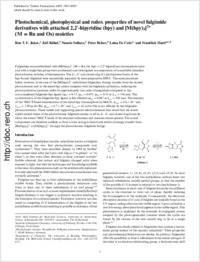Photochemical, photophysical and redox properties of novel fulgimide derivatives with attached 2,2′-bipyridine (bpy) and [M(bpy)₃]²⁺ (M = Ru and Os) moieties
- Jukes, Ron T. F. Van't Hoff Institute for Molecular Sciences, University of Amsterdam, The Netherlands
- Kühni, Joël Institute of Inorganic Chemistry, University of Fribourg, Switzerland
- Salluce, Nunzio Institute of Inorganic Chemistry, University of Fribourg, Switzerland
- Belser, Peter Institute of Inorganic Chemistry, University of Fribourg, Switzerland
- Cola, Luisa De Physikalisches Institut, Westfälische Wilhelms-Universität, Münster, Germany
- Hartl, František Van't Hoff Institute for Molecular Sciences, University of Amsterdam, The Netherlands
-
26.03.2009
Published in:
- Dalton Transactions. - 2009, p. 3993-4002
English
Fulgimides monosubstituted with [M(bpy)₃]²⁺ (M = Ru, Os; bpy = 2,2′-bipyridine) chromophore units and with a single bpy group were synthesized and investigated as components of conceivable dinuclear photochromic switches of luminescence. The E-, Z- and closed-ring (C) photoisomer forms of the bpy-bound fulgimide were successfully separated by semi-preparative HPLC. The same procedure failed, however, in the case of the [M(bpy)₃]²⁺-substituted fulgimides. Energy transfer from the excited photochromic unit to the metal-bpy centre competes with the fulgimide cyclization, reducing the photocyclization quantum yields by approximately one order of magnitude compared to the non-complexed fulgimide-bpy ligand (φEC = 0.17, φEZ = 0.071, φZE = 0.15 at λexc = 334 nm). The cycloreversion of the fulgimide-bpy ligand is less efficient (φCE = 0.047 at λexc = 520 nm). The intensity of the ³MLCT-based luminescence of the metal-bpy chromophore (in MeCN, φdeaer = 6.6 × 10⁻² and τdeaer = 1.09 μs for Ru; φdeaer = 6.7 × 10⁻³ and τdeaer = 62 ns for Os) is not affected by the fulgimide photoconversion. These results and supporting spectro-electrochemical data reveal that the lowest triplet excited states of the photochromic fulgimide moiety in all its E-, Z- and closed-ring forms lie above the lowest ³MLCT levels of the attached ruthenium and osmium chromophores. The actual components are therefore unlikely to form a triad acting as functional switch of energy transfer from [Ru(bpy)₃]²⁺ to [Os(bpy)₃]²⁺ through the photochromic fulgimide bridge.
- Faculty
- Faculté des sciences et de médecine
- Department
- Département de Chimie
- Language
-
- English
- Classification
- Chemistry
- License
-
License undefined
- Identifiers
-
- RERO DOC 12223
- DOI 10.1039/b821637c
- Persistent URL
- https://folia.unifr.ch/unifr/documents/301161
Statistics
Document views: 113
File downloads:
- pdf: 162
